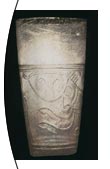The Middle Roman Imperial Period (2nd - 3rd Century AD)
Sparkles From The Deep
The Middle Roman Imperial Period (2nd - 3rd Century AD)

Glass
specimens in The Bodrum Museum of Underwater Archaeology from the Middle Roman
Imperial Period are dated from the end of the 1st century to the beginning of
the 3rd century AD. It is very difficult to date glassware which came to the
museum by means other than excavation. Some types of glassware were greatly
admired and used throughout the entire Roman period; some types were produced
for only a short time. There are a few drinking cups from the Middle Roman
Imperial period in The Museum of Bodrum. Bowls, with or without a base, were for
daily use. A decorated jug on display in The Museum of Bodrum is one example of
the luxury glass of that age.
There is only one miniature jar in the museum’s collection. These miniature
jars were found in the excavations of Anavarza. It is accepted knowledge that
these were left in graves with perfume inside (M.Stern, 1989, p.602, photo 11).
The Bodrum Museum has single specimens of globular and cylindrical-shaped
bottles, used as dinnerware, and of square bottles, used as storage containers.
Only the ones with collared rims and globular bodies were produced in the
workshops around Karia. Another cylindrical body-shaped bottle was found in a
tomb during the excavation of Kaunos. The smaller of these bottles were used for
storing perfume; the bigger ones were used for medicine. Similar bottles were
found in the tomb of a chemist in Syria (see. M.Stern, 1989, p.603-604). A
cylindrical-shaped large bottle found in Marmaris, along with other items, are
examples of the luxury goods of that age. A ribbed-bottle, found with the
cylindrical bottle, was dated to the 1st century AD. It is quite natural that
these glass specimens were found in different places. The handled,
cylindrical-shaped bottle or jug was used in daily life, as dinnerware. Some of
the glass of this kind is in the form of urns, which were used to store the
ashes after cremation. These urns are seen mostly in central Europe (D.B.
Harden, 1988, p.96-97, fig.38-39). This glass item is among the finest on
display at The Museum of Bodrum.
There is only one square bottomed bottle in The Bodrum Museum of Underwater
Archaeology. Square bottomed bottles were used for storage purposes. This square
bottomed bottle in the museum is made using the half-mold blowing technique.
There are four hop-nails around the relief grooves in the center of its base.
Perfume bottles make up the majority of the glass items from the Middle Roman
Imperial Period in The Bodrum Museum of Underwater Archaeology. One example is
the candlestick-shaped unguentariums, which are free-standing. More common types
were cone-shaped, bell-shaped, triangular and flat-triangular-shaped perfume
bottles. All were made by free-blowing and have a light blue-green colour. These
were used as both daily-ware and funeral gifts, and were sold filled with
perfume in ancient city markets or shops.
All of them were locally produced in a short amount of time and were
relatively inexpensive.
The Bodrum Museum’s glass specimens from 2nd century AD were generally made
for storage purposes or for daily use as dinnerware and produced in or near the
region of Karia, for example in the Aegean region.